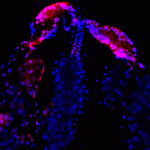Lien vers Pubmed [PMID] – 30753180
PLoS Negl Trop Dis 2019 Feb;13(2):e0007116
BACKGROUND: Transmission of dengue virus (DENV) from humans to mosquitoes represents a critical component of dengue epidemiology. Examinations of this process have generally been hampered by a lack of methods that adequately represent natural acquisition of DENV by mosquitoes from humans. In this study, we assessed artificial and natural blood feeding methods based on rates of DENV infection and dissemination within mosquitoes for use in a field-based epidemiological cohort study in Iquitos, Peru.
METHODOLOGY/PRINCIPAL FINDINGS: Our study was implemented, stepwise, between 2011 and 2015. Participants who were 5 years and older with 5 or fewer days of fever were enrolled from ongoing clinic- and neighborhood-based studies on dengue in Iquitos. Wild type, laboratory-reared Aedes aegypti were fed directly on febrile individuals or on blood collected from participants that was either untreated or treated with EDTA. Mosquitoes were tested after approximately 14 days of extrinsic incubation for DENV infection and dissemination. A total of 58 participants, with viremias ranging from 1.3 × 102 to 2.9 × 106 focus-forming units per mL of serum, participated in one or more feeding methods. DENV infection and dissemination rates were not significantly different following direct and indirect-EDTA feeding; however, they were significantly lower for mosquitoes that fed indirectly on blood with no additive. Relative to direct feeding, infection rates showed greater variation following indirect-EDTA than indirect-no additive feeding. Dissemination rates were correlated across all feeding methods. No differences were detected in DENV infection or dissemination rates in mosquitoes fed directly on participants with different dengue illness severity.
CONCLUSIONS/SIGNIFICANCE: Our study demonstrates the feasibility of using direct and indirect feeding methods for field-based studies on vector competence. Direct mosquito feeding is preferable in terms of logistical ease, biosecurity, and reliability.

